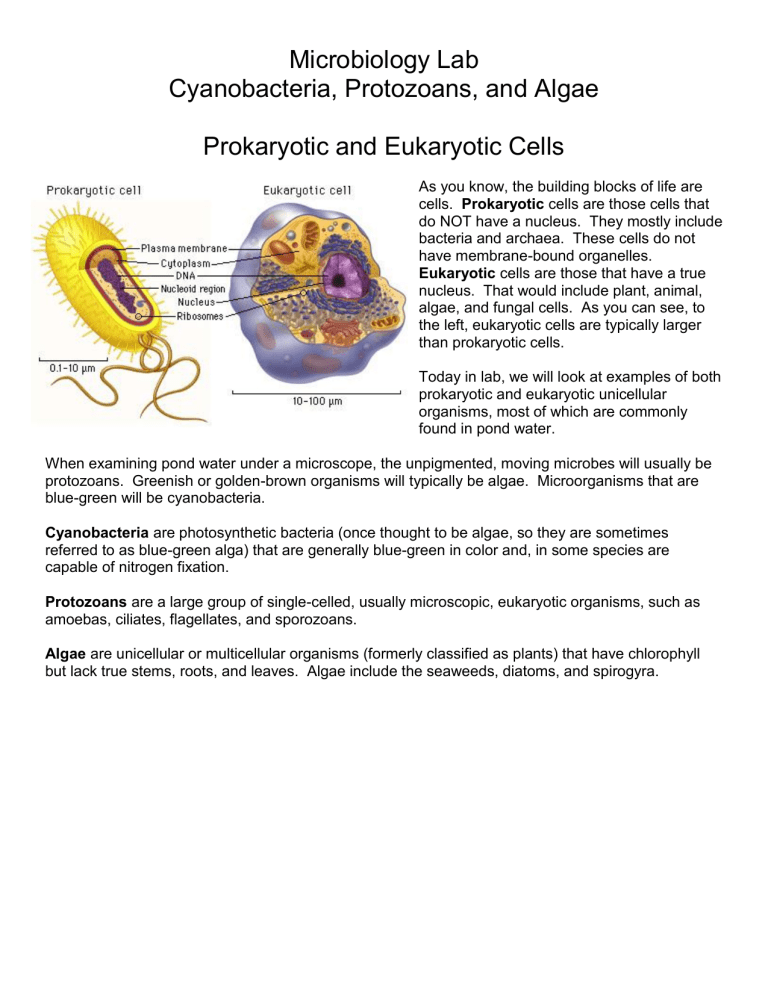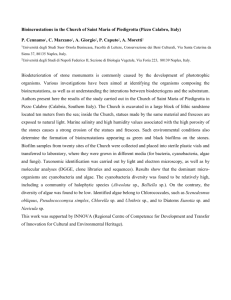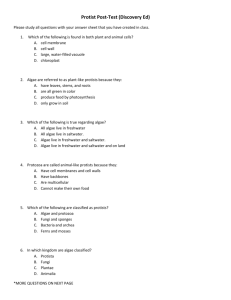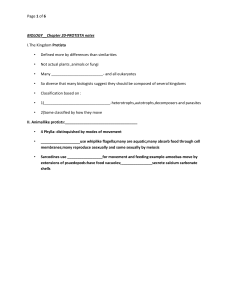Microbiology Lab Cyanobacteria, Protozoans, and Algae Prokaryotic

Microbiology Lab
Cyanobacteria, Protozoans, and Algae
Prokaryotic and Eukaryotic Cells
As you know, the building blocks of life are cells. Prokaryotic cells are those cells that do NOT have a nucleus. They mostly include bacteria and archaea. These cells do not have membrane-bound organelles.
Eukaryotic cells are those that have a true nucleus. That would include plant, animal, algae, and fungal cells. As you can see, to the left, eukaryotic cells are typically larger than prokaryotic cells.
Today in lab, we will look at examples of both prokaryotic and eukaryotic unicellular organisms, most of which are commonly found in pond water.
When examining pond water under a microscope, the unpigmented, moving microbes will usually be protozoans. Greenish or golden-brown organisms will typically be algae. Microorganisms that are blue-green will be cyanobacteria.
Cyanobacteria are photosynthetic bacteria (once thought to be algae, so they are sometimes referred to as blue-green alga) that are generally blue-green in color and, in some species are capable of nitrogen fixation.
Protozoans are a large group of single-celled, usually microscopic, eukaryotic organisms, such as amoebas, ciliates, flagellates, and sporozoans.
Algae are unicellular or multicellular organisms (formerly classified as plants) that have chlorophyll but lack true stems, roots, and leaves. Algae include the seaweeds, diatoms, and spirogyra.
Prokaryotic Organisms - The Cyanobacteria
Cyanobacteria belong to Domain Bacteria. These microscopic organisms lack nuclei. They were once classified as algae because they have chlorophyll a . This explains why they are often referred to as the blue-green algae . Cyanobacteria do not contain chloroplasts. Over a 1,000 species of cyanobacteria have been reported. They are present in almost all moist environments. We will look at two examples of cyanobacteria:
Anabaena
Oscilltoria
Anabaena
is a filamentous cyanobacteria that exists as plankton. It is known for its nitrogen fixing abilities.
Anabaena can develop akinetes (thick walled resting cells that can survive in sediments for many years). It possesses heterocysts, which, during times of low environmental nitrogen, supply neighboring cells with fixed nitrogen in return for the products of photosynthesis. About one cell out of every ten will differentiate into a heterocyst that can no longer perform photosynthesis. This separation of functions is essential because the nitrogen fixing enzyme in heterocysts, nitrogenase, is unstable in the presence of oxygen.
Some Anabaena form symbiotic relationships with certain plants, such as the mosquito fern.
Anabaena are one of four genera of cyanobacteria that produce neurotoxins , which are harmful to local wildlife, as well as farm animals and pets. Production of these neurotoxins is assumed to be a part of its symbiotic relationships, protecting the plant from herbivores.
Oscillatoria
is a genus of filamentous cyanobacterium which is named for the oscillation in its movement. Filaments in the colonies can slide back and forth against each other until the whole mass is reoriented to its light source. It is commonly found in watering-troughs waters, and is mainly blue-green or brown-green. Oscillatoria is an organism that reproduces by fragmentation .
The Protists - Eukaryotic Organisms
Kingdom Protista
Single-celled, eukaryotic organisms are called protists . They are grouped together in Kingdom
Protista . Those protists that are animal-like are put in Subkingdom Protozoa , and the protists that are plantlike belong to Subkingdom Algae .
The Protists – Subkingdom Protozoa
Members of Subkingdom Protozoa, known as the protozoans , have a cell membrane (the pellicle) but lack cell walls. The nuclei are distinct, and the cells often have specialized organelles such as contractile vacuoles, mitochondria, flagella, and cilia. All protozoans produce cysts which are resistant dormant stages that enable the protozoans to withstand drought, heat, and freezing. The protozoans we will look at today include the following:
Amoebas
Paramecium
Plasmodium
Amoebas
are unicellular heterotrophs (they must eat food, as all other animals). They obtain food through phagocytosis , utilizing pseudopods to entrap their meals.
Amoebas
’ most recognizable features include one or more nuclei and a simple contractile vacuole to maintain osmotic equilibrium. Like other eukaryotic organims, they reproduce through asexually via mitosis and cytokinesis, not binary fission, which is how prokaryotes reproduce.
Watch this video of an amoeba in action! http://youtu.be/W6rnhiMxtKU
Parmecium
are unicellular, ciliated protozoans (microscopic animals). Simple cilia cover the body, which allow the cell to move with a synchronous motion (like a caterpillar) at speeds of approximately 12 body lengths per second. There is also a deep oral groove containing inconspicuous tongue-like compound oral cilia used to draw food inside. They generally feed on bacteria and other small cells. Osmoregulation is carried out by a pair of contractile vacuoles, which actively expel water from the cell absorbed by osmosis from their surroundings. Paramecia are widespread in freshwater environments.
Watch this video of paramecium in action! http://youtu.be/l9ymaSzcsdY
Plasmodium
is a genus of parasitic protists. Humans can become infected with at least 11 species of Plasmodium , resulting in malaria.
Malaria translates literally as “bad air.” It was supposed to be due to swam exhalations, but we now know it to be caused by a parasitic protozoan transmitted to humans by Anopheles mosquitoes. The protozoan occupies human red blood corpuscles
(RBC’s), replicates inside them, and then destroys them as they escape to infect new RBC’s. This lifecycle results in intermittent or remittent fever characterized by attacks of chills, fever, and sweating.
The Protists – Subkingdom Algae
Subkingdom Algae includes all the photosynthetic, eukaryotic protists. Again, they lack the tissue differentiation found in plants. Algae may be unicellular, colonial, or filamentous. Algae have distinct, visible nuclei and chloroplasts. Chloroplasts are organelles that contain photosynthetic pigments which harvest the energy of sunlight to form carbohydrates through a process known as photosynthesis . There are 7 different divisions of algae, but we will examine only a selection of them:
Euglenophycophyta (the euglenoids) – ex. Euglena
Chlorophycophyta (the green algae) – ex. Volvox, Ulothrix, and Spirogyra
Chrysophycophyta (the golden brown algae)
– ex. Diatoms and
Vaucheria
Euglena
are unicellular protozoans that almost always have chloroplasts . Although they photosynthesize
(autotrophy), Euglena can also eat food by heterotrophy (like animals). They use a flagellum for locomotion.
Watch this video of euglena in action! http://youtu.be/0rNI8Bos_BQ
Volvox
is a type of green algae . It forms spherical colonies of up to 50,000 cells. They live in a variety of freshwater habitats. Each mature Volvox colony is composed of numerous flagellate cells embedded in the surface of a hollow sphere.
The cells swim in a coordinated fashion, with distinct anterior and posterior poles.
The cells have eyespots which enable the colony to swim towards light. The spheres will break up with advanced age. The generative cells then grow into new colonies.
Watch this video of volvox in action! http://youtu.be/He9FSeGRi3A
Ulothrix
is a filamentous green algae , generally found in fresh and marine water. Its cells are normally as broad as they are long, and they thrive in the low temperatures of spring and winter. They become attached to surfaces by a modified holdfast cell.
Spirogyra
is a filamentous green algae of the, named for the helical or spiral arrangement of the chloroplasts . It is commonly found in freshwater areas.
Spirogyra measures approximately 10 to 100 μm in width and may stretch centimeters long. This particular algal species, commonly found in polluted water, is often referred to as "pond scum". The cell wall has two layers: the outer wall is composed of pectin that dissolves in water to make the filament slimy to touch while the inner wall is of cellulose. The cytoplasm forms a thin lining between the cell wall and the large vacuole it surrounds. The chloroplasts are ribbon shaped, serrated or scalloped, and spirally arranged. In spring Spirogyra grows under water, but when there is enough sunlight and warmth they produce large amounts of oxygen, adhering as bubbles between the tangled filaments. The filamentous masses come to the surface and become visible as slimy green mats.
Diatoms
are a major group of golden brown algae , and are one of the most common types of phytoplankton (microscopic plants). Diatoms are primary producers within the food chain. Most diatoms are unicellular, although they can exist as colonies in the shape of filaments or ribbons, fans, zigzags, or stellate colonies. Diatom cells are characteristically encased within a unique cell wall made of silica (hydrated silicon dioxide) called a frustule . These frustules show a wide diversity in form, but usually consist of two symmetrical sides with a split between them , hence the group name.
Vaucheria
is another golden brown algae . Vaucheria exhibits apical growth from the tip of filaments forming mats in either terrestrial or freshwater environments.
Its filaments form coenocytes with a large central vacuole pushing against the surrounding cytoplasm; the vacuole extends along the entire filament except for the growing tip. The chloroplasts are located on the periphery of the cytoplasm with the nuclei aggregating toward the center near the vacuole.








